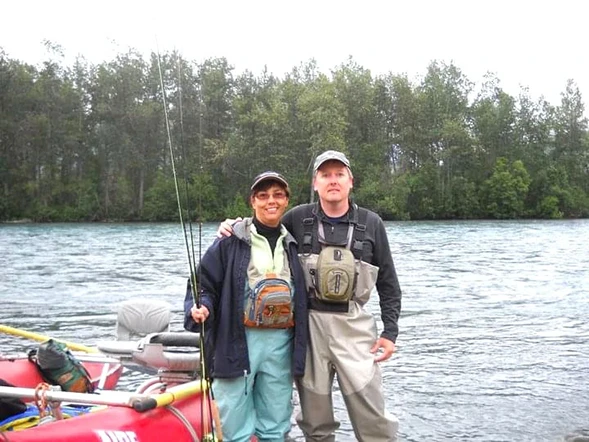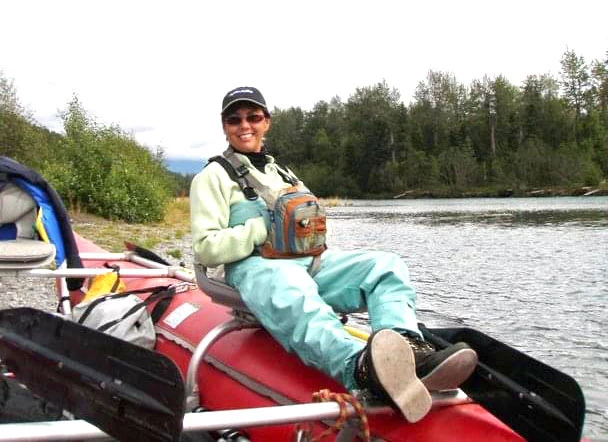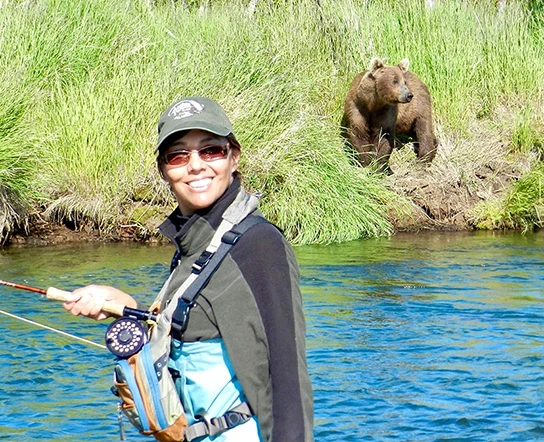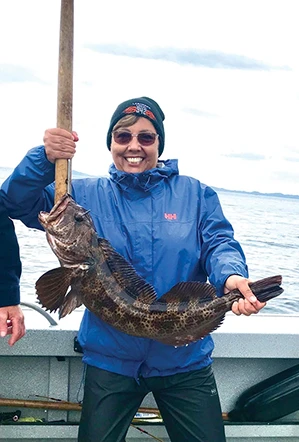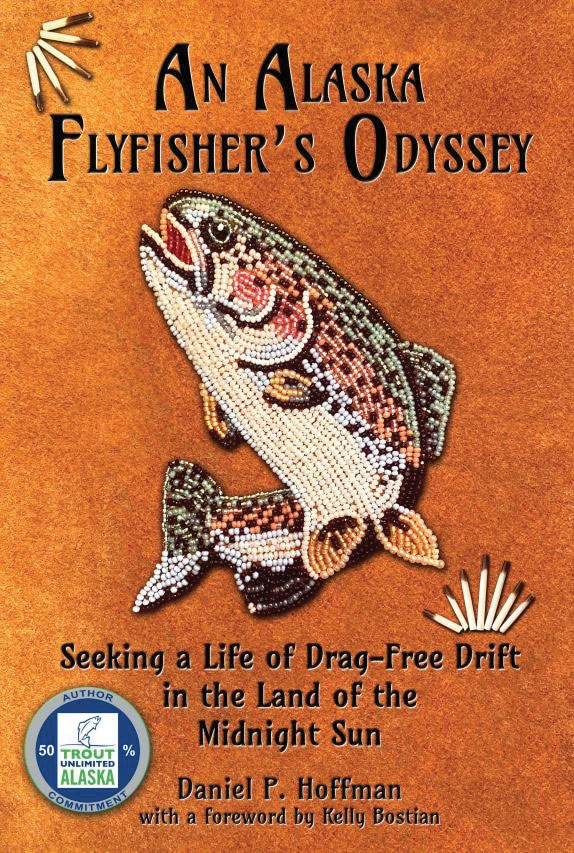Dry-dropper rigs are a versatile and popular setup used in fly fishing. This rig allows anglers to cover multiple parts of the water, increasing their chances of a bite. In this excerpt from An Alaska Flyfisher’s Odyssey: Seeking a Life of Drag-Free Drift in the Land of the Midnight Sun, author Dan Hoffman reflects on the dry-dropper rig and its similarities to the roles and dynamics of marriage.
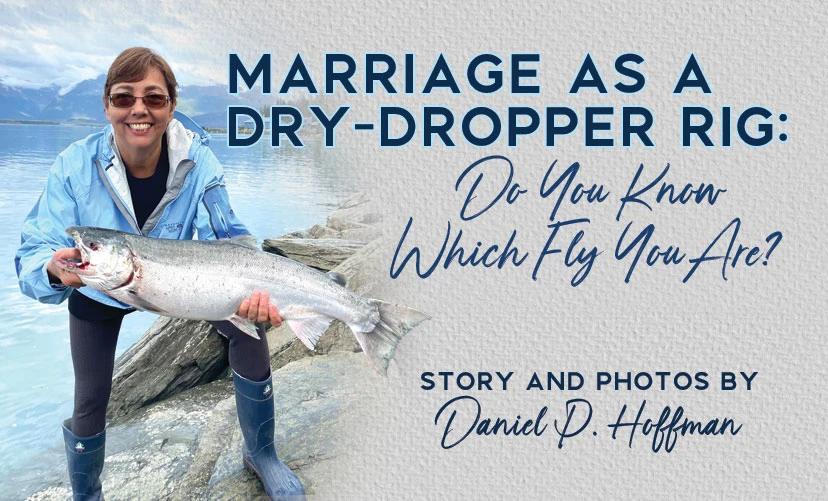
This piece is a reprint of Chapter 13 from Daniel Hoffman’s 2022 book An Alaska Flyfisher’s Odyssey: Seeking a Life of Drag-Free Drift in the Land of the Midnight Sun. Now in its second printing from Sweetgrass Books and Farcountry Press, Daniel continues to donate 50% of all book profits to Trout Unlimited Alaska, in furtherance of their efforts to protect and enhance trout and salmon habitat. An Alaska Flyfisher’s Odyssey can be found in Barnes and Noble stores, at select fly shops, and online through Amazon.com or directly through Farcountry Press.
A Spark of Connection
My wife Gwen drives a nice little Honda. It’s an all-wheel-drive SUV that scoots up and down our hill through the worst of winter conditions, and she knows how to handle it when navigating our road’s steep switchbacks. I often find myself riding as her passenger when we head into town on errands, as her rig gets better mileage than my pickup. I save the truck for when our tasks include hauling water, as there’s a large tank strapped into the bed that we use for that particular chore.
Regardless of who’s driving, we’ve developed an instinctive ritual when pulling into the garage at home. Fairbanks is exceedingly dry, especially in the wintertime, with a relative humidity that’s comparable to most desert locations. That’s why we’re far more comfortable in Fairbanks at -30°F than in the coastal town of Anchorage at -10°F, as we laughingly tell our friends to the south: “It’s a dry cold.” As a result of the excessive dryness, and with conditions commonly exacerbated by the numerous layers of winter clothing that invariably rub together, we’ve found it necessary to reach over and lightly touch one another with a bare finger, (providing an adequate “ground” for our human circuit) before leaning in for the routinely celebratory, good-to-be-home kiss. Failure to do so inevitably leads to the discharge of a sharp, static shock across one’s lips—contributing to a Pavlovian condition of negative response that I’d rather not reinforce.

Dan and Gwen in uniform, shortly before both retired.

Dan and Gwen Hoffman on their wedding day, 28 years ago.
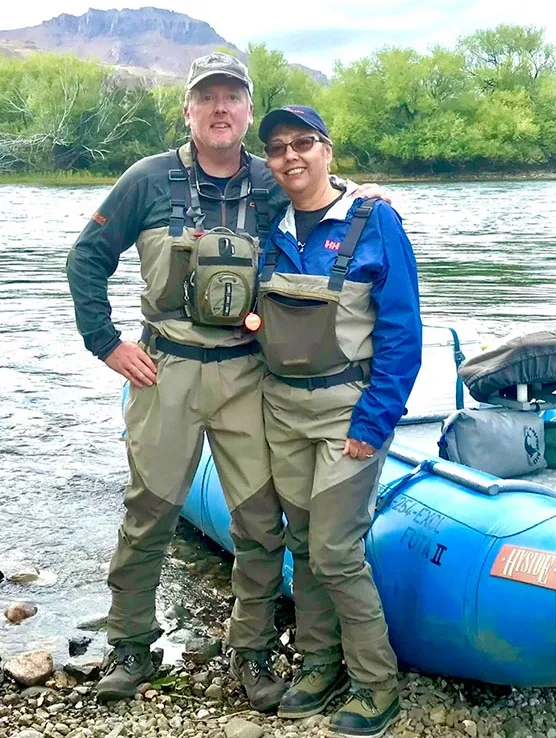
Dan and Gwen enjoying a float fishing trip on the Limay River in Argentina.
Occupational Introduction
When you’re together with a person long enough, you eventually figure out what works. I first met Gwen while working as a young police officer in Fairbanks, where she was already serving as an Emergency 911 Dispatcher. For the first three years that I knew her through work, our relationship basically consisted of her telling me where to go, who to see, and what to do. I figured I probably shouldn’t mess with the established order of things once we started dating and getting serious; as they say, “If it ain’t broke…”
I knew that I was defying conventional wisdom in pursuing a romance on the job, though I think it’s much more common in emergency services than in many other occupations. When you’re working swings or graveyard shifts with midweek days off, it can be hard to find opportunities to socialize with the normal folk. Additionally, the people involved in our line of work are some of the few who realize the true nature (and stressors) of what we see and deal with on a day-in, day-out basis. I know I’m not the first cop to marry a dispatcher, and I likely won’t be the last.
The Dry-Dropper Analogy
We just celebrated our 28th wedding anniversary this summer. I know that probably doesn’t qualify as a monumental benchmark for some of the old-timers out there, but I feel like we have a pretty good running start on things.
I won’t pretend that I have everything solidly figured out at this point, as all the fellow married men out there would surely laugh at such an assertion, and rightly so. I do tend to be somewhat introspective at times, and I’ve often wondered if I would ever come across some analogy or circumstance that would help me explain to others how I viewed the respective roles in Gwen’s and my relationship. It wasn’t until a few years ago, while using a guide’s services in New Zealand to explore some of their local trout water with a tandem-fly setup, that it hit me like a ton of bricks: Our marriage was a classic, dry-dropper arrangement!
Now I’m assuming that many of this magazine’s readers are fly anglers, and therefore know exactly what a “dry-dropper” refers to. If you haven’t fished such a setup, especially at the hands of a guide, then I can only assume you’ve joined company with the resident caddis larvae and have been living under a rock for the past 30 years. However, I hope you’ll indulge me for just a moment as I relate a brief history and evolution of our sport, allowing me to bring the rest of our esteemed readers up to speed.
Feeling for a Bite
As most fly anglers know, the majority of any trout’s diet can be found scurrying about the surface of a stream’s bed or drifting amongst its currents. These food items are generally lumped together and classified as nymphs, to include pupal and larval forms of midges, caddis, stoneflies, and a host of others. Trout tend to hold in water where such items will come floating by or directly to them, allowing them to eat while expending as little energy as possible. Consequently, the savvy nymph fisherman will drift their imitations within close proximity to the lanes of a feeding trout, endeavoring to match the proper depth and drift for each offering. When everything matches up and comes together successfully—Bam! Fish on.
There’s a minor complication, however. As it turns out, trout and other salmonids can be extraordinarily delicate eaters; a small nymph can be mouthed by the fish, only to be spit back out in such rapid fashion that the angler will have no idea that a take had ever occurred. Traditional (and recently resurging) “tight-line” nymph fishermen attempt to overcome this problem by keeping as little slack in their lines as possible, attempting to feel every tick and bump of their fly’s progress as it bounces along the streambed cobble. The tight-liner will sometimes cheat a bit, using a short, brightly colored length of “sighter material” built into their leader, as that provides a method allowing for the visual recognition of soft takes.
If you have ever fished with an accomplished nymph fisherman, you’ve likely recognized their superior skillset. Knowledgeable nymphers can almost always outfish anyone else on a stream, as they’re targeting the bulk of their quarry’s diet.
New Generation of Anglers
While it’s hard to believe, one will often run into individuals on the water that are slightly less than knowledgeable. When a certain, popular flyfishing movie came out in the early ‘90s, it was credited with bringing a whole new wave of people to the sport. I suspect that this may indeed be true; what I know for certain is that there suddenly seemed to be a lot more people attempting to flyfish, and many of these folks didn’t seem to have the time or patience necessary to learn the intricacies of fishing by feel. Enter the indicator.
The variety of different types of indicators, and their general use, seemed to explode in the ‘90s. Guides, in particular, likely found that all their newbie clients could be taught to raise their rod tip in a quick hookset much more easily when presented with an easily visible, floatable cue to do so. The use of an indicator became a standard part of the setup for most nymphing rigs; the marginally competent angler could now focus on establishing a proper drift, then simply wait for the telltale twitch of their yarn or Thingamabobber to set the hook.
Evolution of the Dry-Dropper Rig
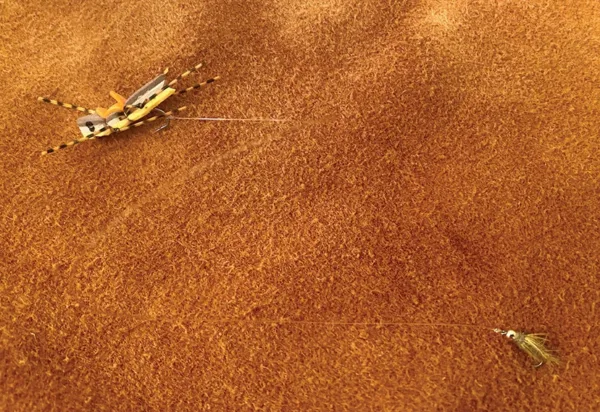
Dry-Dropper tandem fly example (foam hopper paired with a bead-head nymph).
It’s not hard to imagine how the next, inevitable step in the evolutionary process occurred. As guides across the country closely watched while clients drifted indicators in their nymphal pursuits, occasional circumstances would likely arise when a hatch would start to occur, with natural flies being taken on the surface in preference over subsurface offerings. In other cases, a trout may have struck at the angler’s indicator, mistaking its silhouette for that of an egg or floating terrestrial. No matter the circumstance, hundreds of guides and experienced anglers across the country likely reached the same, independent conclusion: If I’m going to float something on the surface to act as an indicator for my nymph, why not just use a dry fly that might draw its own strikes in the process? And…hail to the chief…the dry-dropper rig rose to quick prominence.
Testing the Waters
I avoid fishing dry-dropper setups when I can get away with it—usually indicative of those circumstances where a primary food source is so overwhelming (e.g., fish eggs present, a heavy hopper hatch, etc.) that any additional, offered choices are wholly unnecessary. I like to keep track of the minimum number of variables possible, and I hate undoing tangles, particularly if a split-shot is involved. However, when one needs to cover a lot of water, and especially when one’s trying to figure out what’s being eaten, prospecting with a dry-dropper rig is hard to beat. It simply allows one to cover more bases, often significantly accelerating the determination as to what the day’s favorite fly is going to be, allowing for the secondary offering to then be ditched if desired.
So…We should now all be on the same page when it comes to dry-droppers; but how could that possibly pertain to marriage? Well, if you’ve ever fished such a setup—and paid any attention to what was being accomplished in the process—then you might already start to catch some of my drift. (Sorry; I promised my wife that I’d scale back on my fish puns, once I’d left school).
Collaborative Success
When fishing a dry-dropper rig, one no longer relies upon a single fly drifting along the currents, venturing forth in solitary pursuit of its life’s intended mission. Rather, there are now two flies being fished—working together in a closely coordinated fashion—in an effort to achieve success and the happiness that results. The flies are commonly quite different from one another in many respects, and it’s often the result of this purposefully paired dissimilarity that contributes to the overall setup’s success. The relationship can sometimes get a bit messy, as keeping things flowing smoothly with a minimum of tangles is inherently more difficult when fishing two flies as opposed to one. However, when done correctly and pursued with continuous good faith, the results will likely far eclipse that of the single fly’s solitary journey.
The two flies comprising a dry-dropper setup obviously have different roles. The dry fly that floats along the surface often provides an overall sense of visible direction, and its presence will invariably draw additional opportunities to the relationship, sometimes resulting in the most prized catch of the day. Often unseen as it toils beneath the surface, the dropper may frequently be doing the lion’s share of the work; it sometimes doesn’t seem to be as highly recognized or appreciated in its underwater role, until such time that it hooks a fine fish for retrieval. Both flies are critical to the pair’s overall success, and neither should assume an attitude of prominence or superiority.
Which Dry-Dropper Rig Fly Are You?
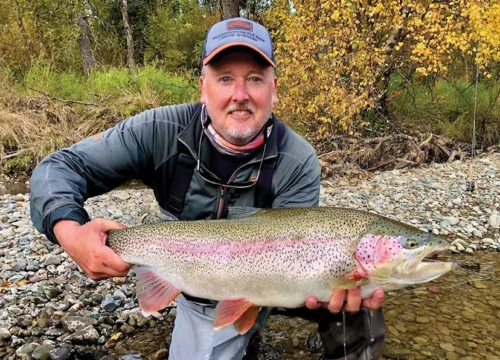
Daniel Hoffman
When one accepts my offered premise, the next question from married folks logically follows: O.K., if my relationship is that of a dry-dropper, which one am I? This seemingly innocuous inquiry quickly cuts to the heart of the matter, as the dynamics between two flies fished in coordinated fashion can alter considerably over the course of a single drift, much less throughout an entire day’s angling efforts. The easiest way to illustrate the common characteristics and potential pitfalls of each fly’s performance will lie in an examination of specific potential circumstances, which I’ll enumerate shortly.
However, before proceeding, please allow me to declare this one, important caveat: When I speak of a failing on the part of either fly (or use the word “spouse” in any accompanying analogy) this should be strictly interpreted to mean “Daniel Hoffman, the clueless husband” when viewed within the context of my own relationship. I’m assuming that Gwen may read this at some point in the future, so I just wanted to make sure and throw that out there…
PROBLEM AREA #1: USING A DRY FLY OF INSUFFICIENT BUOYANCY.
The dry fly used in a tandem setup will normally catch fewer fish than its subsurface partner, and that’s often by design. The fact that the dry isn’t the primary “fish-catcher” should in no way diminish the importance of its overall role. By floating on the surface, and in maintaining the direct connection to its partner underneath, the dry fly will provide the subtle cues necessary for the nymph to achieve success. A small midge pattern fished through the currents can be inhaled and spit out dozens of times over the course of a day; if the dry doesn’t do its job and provide an indication for the subsurface takes, then their partner is likely working for naught.
In consideration for this role, the dry fly that’s chosen to serve as an indicator must be up to the task, possessing the character and qualities necessary to maintain its sense of floatation and purpose, even through choppy waters. Prospective nymphal spouses would do well to choose their dry partners carefully; the daintiest of floating patterns may look quite flashy in the fly shop’s display case but will likely succumb to submersal when faced with the currents of real life. The true “indicator-dry” will remain steadfast and buoyant through the roughest of conditions, contributing to the partnership’s ongoing success.
PROBLEM AREA #2: USING A DROPPER THAT’S TOO MUCH OF A LIGHTWEIGHT.
As reflected above, the largely unseen role of the dropper is no less important. The dropper will normally assume the task of catching the most fish, or, at the very least, provide the necessary prospecting and exploration necessary to chart the pair’s continued course through the stream. There’s a reason that the dropper rides below the surface; that’s where the fish are. However, to be a truly effective partner, the dropper cannot simply posture at success by merely slipping below the surface. The dropper needs to work at the correct depth, as the dry deserves far more in a partner than the feigned efforts of a mere poser.
While many natural nymphs can be found at varying depths throughout the water column, particularly when dealing with emergent phases, many are commonly found near the bottom where they live and become frequently detached. One can fish the finest nymph reproductions out there, but if those offerings are sailing high over the heads of the trout that are feeding at depth, then the dropper’s efforts are futile at best; and, at their worst, may actually represent a purposeful display of disingenuous sincerity. It’s the job of the nymph to get down and do the hard work, wherever it’s necessary. If unwilling or unable to do so, then a different partner should’ve perhaps been chosen.
PROBLEM AREA #3: USING A DROPPER THAT’S TOO HEAVY.
Just as using a dropper that’s too light will lead to a highly diminished chance for success, so too shall that of a nymph that’s too heavily weighted for prevailing conditions. As referenced previously, many natural nymphs and emergers will commonly ride the mid-depth currents, often rising to even higher levels as they prepare to breach the film. If one attempts to throw a heavily weighted offering amid such conditions, it’s likely that the prospective meal will drift well below any feeding trout, failing to draw any strikes in the process. Worse yet, the overweight nymph will likely get hung up on the stream’s bottom with frustrating regularity, further complicating what should otherwise be a happy relationship between the two tandem flies.
Within the context of the marital analogy, however, the most serious consequence manifesting from such a condition can result when the dry is unintentionally dragged beneath the surface by its overweight and singularly focused dropper. It’s the job of the nymph to work with its partner, not to drown it. For those circumstances when it’s necessary for the dropper to seek or maintain greater depth, then it’s incumbent upon the angler to make an honest adjustment with the dry, ensuring the health and survivability of both partners.
PROBLEM AREA #4: COMPLICATING THE RIG WITH UNNECESSARY WEIGHT.
It has often been said that the difference between a good fisherman and a great one is a single split-shot, and for good reason. When considering how to fish one’s dropper in a tandem rig, it’s critical to get the nymph down to the proper level in the water column, which can often mean the addition or subtraction of shot as necessary. However, despite its benefits, the inevitable motion of a shot freely swinging on one’s leader when airborne produces its share of complications.
As I’ve alluded to before, I hate tangles. I don’t curse often—especially when I find myself upon the calm and soothing waters of a trout stream—but when faced with the pendulum-swinging, in-your-face movement of a gyrating split-shot while I attempt to resolve what had started out as a simple tangle—well, it’s at that point that I sometimes find myself stretching the limits of my vocabulary. Fishing two flies is complicated enough for me, and I’ll avoid adding extra, mid-tippet weight whenever possible. If I do need to add a shot, I’ll use the minimum amount necessary to achieve results, or consider switching to a dropper with a more properly weighted body. One should avoid adding additional complications to the relationship between two tandem flies whenever possible.
PROBLEM AREA #5: INTRODUCING A THIRD FLY INTO THE MIX.
Sorry, but you’re going to have to head to a different type of bookstore if you’re looking for a story extolling the benefits of three-fly setups. The standard dry-dropper rig works quite well, as it allows the angler to manage two committed partners in tandem, keeping any extraneous elements to an absolute minimum. For anyone who has already subscribed to the applicability of this overall analogy, I doubt that anything further need be said.
Speaking of wrapping things up, it’s probably time for me to do the same. I should likely ask Gwen if we need to jump in the car and head down the hill, as we’re getting short on a few grocery items in our pantry. It shouldn’t take long, but we’ll need to grab our heavy jackets, as it’s looking fairly chilly outside. I’m not sure yet, but when we get home and pull into the garage, I may just decide to roll the dice and forgo the standard “grounding touch” before leaning over to give her a quick smooch. I don’t ever want to become too predictable, after all, and I’m always looking for ways to maintain the spark in our relationship.
An Alaska Flyfisher’s Odyssey is available at Farcountrypress.com and on Amazon. When he’s not busy fishing, Daniel is spending more time as a corporate speaker, where he applies the lessons of flyfishing to business, relationships, and life.
For more reading like this dry-dropper rig article, check out Fish Alaska’s Blog Library.

